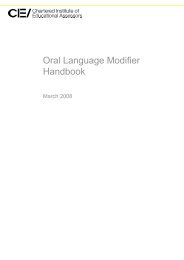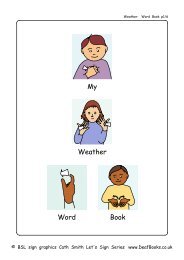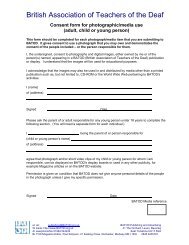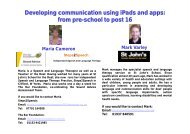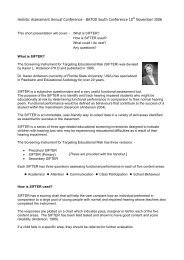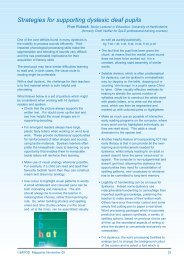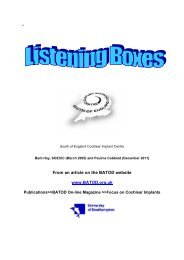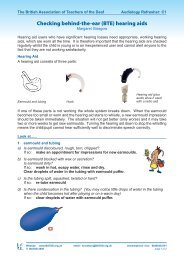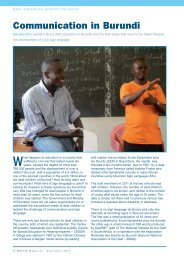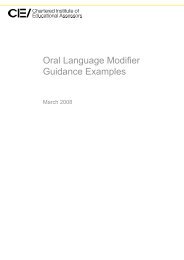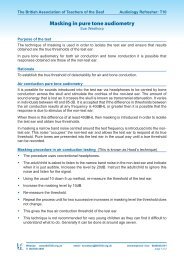Goal fulfilment in school for the deaf and hearing impaired - batod
Goal fulfilment in school for the deaf and hearing impaired - batod
Goal fulfilment in school for the deaf and hearing impaired - batod
- No tags were found...
You also want an ePaper? Increase the reach of your titles
YUMPU automatically turns print PDFs into web optimized ePapers that Google loves.
Table 26. Proportion (%) <strong>in</strong> respect of importance <strong>for</strong> choice of <strong>school</strong>, per type of <strong>school</strong>.Special<strong>school</strong>Hear<strong>in</strong>g class<strong>school</strong>IndividuallyplacedCompulsory<strong>school</strong> <strong>for</strong>learn<strong>in</strong>gdisabledHear<strong>in</strong>g technology/hear<strong>in</strong>g resources 12 28 5 4Recommendation from audiologicalhealth care service 18 24 5 5Recommendation from parentassociations2 3 1 1Recommendation from SPM/SIT 10 4 1 17Sign language/bil<strong>in</strong>gual environment 31 14 1 8Proximity to own home 4 5 46 14Friends 11 6 27 7Level of knowledge 3 5 5 20School’s orientation 8 10 9 25was 27%. For pupils at compulsory <strong>school</strong>,outside <strong>the</strong> <strong>school</strong>s <strong>for</strong> <strong>the</strong> hear<strong>in</strong>g <strong>impaired</strong>, <strong>the</strong>figure is only 2%. When we asked <strong>the</strong> teachershow <strong>the</strong> pupils communicate dur<strong>in</strong>g <strong>the</strong> <strong>school</strong>day, teachers at special <strong>school</strong>s respondedthat 63% of <strong>the</strong> pupils communicate by signlanguage.In many surveys, <strong>the</strong> pupils are asked whe<strong>the</strong>r<strong>the</strong>y get headaches dur<strong>in</strong>g <strong>the</strong>ir <strong>school</strong> day, asheadaches can be an <strong>in</strong>dication of shortcom<strong>in</strong>gs<strong>in</strong> <strong>the</strong> environment. Accord<strong>in</strong>g to <strong>the</strong> parentsof pupils at special <strong>school</strong>s, 8% say that <strong>the</strong>irchildren often or always have headaches. Asregards hear<strong>in</strong>g <strong>impaired</strong> <strong>and</strong> <strong>deaf</strong> pupils <strong>in</strong>o<strong>the</strong>r types of <strong>school</strong>s, <strong>the</strong> correspond<strong>in</strong>g figuresare 10 <strong>and</strong> 12% respectively. Most of <strong>the</strong>m areafflicted dur<strong>in</strong>g or after <strong>the</strong> <strong>school</strong> day. Thiscan be an <strong>in</strong>dication that <strong>the</strong> <strong>school</strong>’s work<strong>in</strong>genvironment is not optimal <strong>for</strong> many hear<strong>in</strong>g<strong>impaired</strong> pupils, <strong>and</strong> many studies have alsoattempted to illustrate this problem (Bergkvist2001; Coniavitis Gellerstedt 2007a; L<strong>in</strong>dahl& Nilsson 2007; Nordén, Tv<strong>in</strong>gstedt & Äng1990;Tv<strong>in</strong>gstedt 1993).ParticipationParticipation <strong>in</strong> one’s environment usually<strong>in</strong>volves be<strong>in</strong>g able to take part <strong>in</strong> <strong>the</strong> activitiesoffered without be<strong>in</strong>g confronted by anyobstacles or difficulties. Participation as a process<strong>for</strong> atta<strong>in</strong><strong>in</strong>g knowledge has become <strong>in</strong>creas<strong>in</strong>glyimportant <strong>in</strong> <strong>school</strong>. When us<strong>in</strong>g <strong>the</strong> concept <strong>in</strong>this assessment, we referred to <strong>the</strong> ICF <strong>in</strong> whichit is def<strong>in</strong>ed as ‘<strong>in</strong>volvement <strong>in</strong> a life situation’(Socialstyrelsen 2003).The pupils <strong>in</strong>teract with <strong>the</strong>ir surround<strong>in</strong>gstoge<strong>the</strong>r with friends <strong>and</strong> take on challenges<strong>in</strong> order to promote <strong>the</strong>ir ideas <strong>and</strong> <strong>in</strong>terests.Schools must guide pupils <strong>for</strong>ward <strong>in</strong> thisprocess us<strong>in</strong>g curriculum goals so that <strong>the</strong>y canprogress <strong>in</strong>dependently <strong>and</strong> democratically <strong>in</strong>to<strong>the</strong> adult world. Un<strong>for</strong>tunately, <strong>the</strong>y are facedwith a number of obstacles <strong>in</strong> <strong>the</strong> course ofthat progression. We have described above, <strong>for</strong><strong>in</strong>stance, how <strong>the</strong> pupils’ work<strong>in</strong>g environmentas regards <strong>the</strong> acoustic adaptation of premises<strong>and</strong> access to technical auditory equipment wasnot completely satisfactory.50 <strong>Goal</strong> <strong>fulfilment</strong> <strong>in</strong> <strong>school</strong> <strong>for</strong> <strong>the</strong> <strong>deaf</strong> <strong>and</strong> hear<strong>in</strong>g <strong>impaired</strong>



